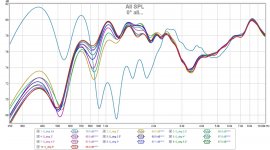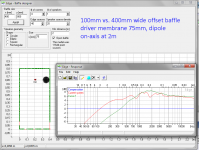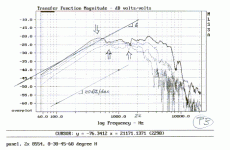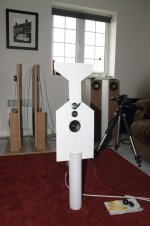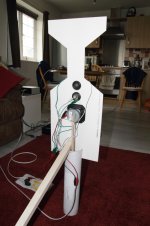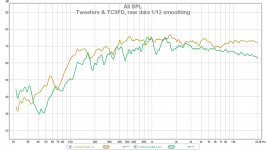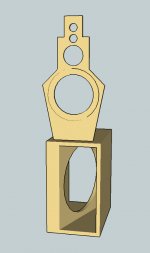What you are asking is what is the advantage of a dipole speaker in the first place. For a dipole to work correctly, the room has to be large enough for the back wave to develop, and the speaker has to be far enough from the wall as to not distort the back wave. The compromises become overwhelming for the DIY'er is a normal sized room. There are easier ways to control directivity, like maybe a constant directivity horn.
I personally believe your work with infinite baffles, which is what your spiral TL really is, is ultimately more productive.
Bob
You have a good point there with the Nautaloss. When I look at the polar response that I get from those speakers, to me, it appears to be the more favorable setup, at least for a smaller room where reflections would be unavoidable.
Some great feedback and insight, looking forward to your updates Rudolf... certainly in no rush so enjoy the Easter period as much as possible 
An extra chart of all the on-axis responses, gives a slightly clearer view of the changes through the mid range as the cut width increased. Rudolf, if you wish any specific combination of data, just ask
From the listening I've done over the last two to three weeks of the pair of open baffle's I built, I do like the sound, but I fear my room is on the slightly to small side. I'd still like to try a narrow baffle OB build just for kicks. However, I think my serious side falls with sealed or TL etc. enclosures... I'm going to build X's Nautaloss and mess about with trying to do a wave guide or something
An extra chart of all the on-axis responses, gives a slightly clearer view of the changes through the mid range as the cut width increased. Rudolf, if you wish any specific combination of data, just ask
From the listening I've done over the last two to three weeks of the pair of open baffle's I built, I do like the sound, but I fear my room is on the slightly to small side. I'd still like to try a narrow baffle OB build just for kicks. However, I think my serious side falls with sealed or TL etc. enclosures... I'm going to build X's Nautaloss and mess about with trying to do a wave guide or something
Attachments
I zoomed into the central area of BMS' dipole measurements. You need to ignore the 80-90° curves in the following animated Gif. They are too difficult to get correctly in a very small room.
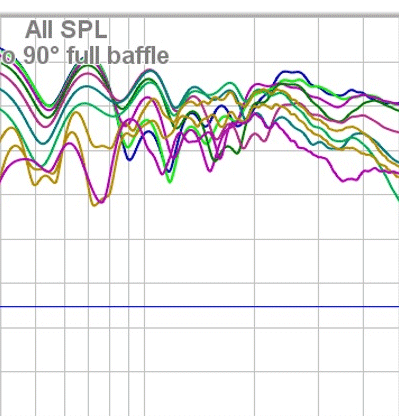
What else do you see? The Gif starts with the closed baffle, which features the somewhat chaotic response pattern that Linkwitz shows for the "b=8a" case in A3-5.
When the gap between inner and outer baffle widens, the response curves get more distance between them (beaming) and a better controlled distance between them (constant directivity). The process starts at the lower frequencies and moves to higher frequencies while the gap widens.
I will discuss with BuildMeSomething how we can get rid of those irritating 80-90° curves.

What else do you see? The Gif starts with the closed baffle, which features the somewhat chaotic response pattern that Linkwitz shows for the "b=8a" case in A3-5.
When the gap between inner and outer baffle widens, the response curves get more distance between them (beaming) and a better controlled distance between them (constant directivity). The process starts at the lower frequencies and moves to higher frequencies while the gap widens.
I will discuss with BuildMeSomething how we can get rid of those irritating 80-90° curves.
^yep. When the distance from the center of the radiating surface to edges is not constant, ripples are smoothend/distributed. The worst case is circular baffle with the source in the middle.
Your baffles, specially the spiral are good compromises. However, some limiting laws of physics can't be broken!
Small/nude dipole give even directivity below dipole null, but need lots of equalization to give 2 octaves range. Wide baffle looses dipole directivity but gives flatter response because of baffle reinforcement instead of dipole loss. If we make a compromise with placing the driver on the edge of a wide baffle, we gain and loose on both frontiers!
As summary - a single fullrange driver works on wide baffle. On-axis response is easy to equalize but but power response/ off-axis radiation is problematic. To get wide range of dipole radiation and smooth power response, one must use multiple drivers and variable width of baffles and lots of equalization per driver, also crossovers are tricky to get right. A dsp device such as minidsp is necessary.
Your baffles, specially the spiral are good compromises. However, some limiting laws of physics can't be broken!
Small/nude dipole give even directivity below dipole null, but need lots of equalization to give 2 octaves range. Wide baffle looses dipole directivity but gives flatter response because of baffle reinforcement instead of dipole loss. If we make a compromise with placing the driver on the edge of a wide baffle, we gain and loose on both frontiers!
As summary - a single fullrange driver works on wide baffle. On-axis response is easy to equalize but but power response/ off-axis radiation is problematic. To get wide range of dipole radiation and smooth power response, one must use multiple drivers and variable width of baffles and lots of equalization per driver, also crossovers are tricky to get right. A dsp device such as minidsp is necessary.
Attachments
Last edited:
S Linkwitz noticed this same problemacy (uneven off-axis response) with his Phoenix dipole speaker's midrange driver/baffle (SEAS L21). I copied here his graph from this page Electro-acoustic models
Attachments
I'm not sure which of the various ripplings you are aiming at. The notches at 500 Hz, 800-900 Hz and 1.2 kHz are due to the floor reflection. You don't see them as much in a multi-driver system with a cleverly choosen Xover point. The downward slope from 1 kHz to 4 kHz is part of the (small) baffle response pattern - you don't see that with a very large pattern and offset driver. The inconsistencies between 0°- and off-axis angles are part of the too-large-to-be-really-called-dipole dilemma.Why did I not get all the rippling in the frequency response on my 12 in wide OB on post #1? Is it the offset that helped?
Question, how important is a good figure '8' polar response if it's only one person listening and from a [roughly] fixed point of a listening chair?
Think of an omnidirectional point source speaker at 2 m distance from your head. It will radiate evenly into a sphere with a surface area of 50.26 m². A very small part of that surface is your head which might cover an area of 0.2x0.2 m = 0.04 m². That is <1/1000 of the surface of the sphere.I guess I am still not sure why a figure 8 directivity pattern is good. Don't we want uniform over as wide an angle as possible?
With all due respect to the primacy of the first wavefront and the frontal orientation of our ears - those other 999/1000 must be of some importance too. Let's not forget that dipole radiation is not an additive pattern - it is an subtractive pattern where about 2/3 of the energy, which is radiated into the room, is annihilated while getting the same forward SPL as the omnidirectional speaker.
That annihilation is most effective in the baffle plane. It is easily 12 dB and more below the 0°-response. +/-30° off the baffle plane the response should be still 6 dB down from the 0°-response. It would be your goal to aim those "silent" areas of the dipole towards the side and front wall reflection points in your room. Look at this illustration in Linkwitz page to get the idea.
Isn't it telling how SL is discussing the optimal in-room positioning of the LX521 before he proceeds to the speaker itself? The primary advantage is the deep and wide constriction of the SPL pattern in the baffle plane over the complete frequency range, which is inevitably connected to the dipole principle.
Certainly not. It would be wrong to aim the loudspeaker radiation pattern at any of the "natural" radiation patterns of some instrument.Or is it a figure 8 pattern most closely resembles natural sources so that directivity and spatial imaging cues can be formed?
Rudolf, I've sent you the first set of REW data. Will start to work on re-imaging the FR charts with common colours and no 80°, 90° lines.
Read the referenced Linkwitz piece a few times now, the chap certainly knows a thing or two. Good to have the importance of figure '8' explained in it's relation to room placment
|-O-|
Have/had a pair of Mission M7ds rear surrounds which I blew, luckily the tweeters are all fine and I now have 4 units to play with...
Put together a very quick baffle using an odd bit of picture-mount card [1.6mm] with two tweeters and a Vifa TC9FD. Shape is not intentional, that's how it was, I just cut three hole roughly along the vertical axis. Very quick EQ to get them level(ish) and had a good long listen... First time I've heard a single speaker disappear as a point source, room reflections helped here, but it was a bit eerie [in a good way] none the less.
Measured at 1m TC9 height, then listening position... Once I get going with this properly I'll post in the multi-driver pages.
Read the referenced Linkwitz piece a few times now, the chap certainly knows a thing or two. Good to have the importance of figure '8' explained in it's relation to room placment
|-O-|
Have/had a pair of Mission M7ds rear surrounds which I blew, luckily the tweeters are all fine and I now have 4 units to play with...
Put together a very quick baffle using an odd bit of picture-mount card [1.6mm] with two tweeters and a Vifa TC9FD. Shape is not intentional, that's how it was, I just cut three hole roughly along the vertical axis. Very quick EQ to get them level(ish) and had a good long listen... First time I've heard a single speaker disappear as a point source, room reflections helped here, but it was a bit eerie [in a good way] none the less.
Measured at 1m TC9 height, then listening position... Once I get going with this properly I'll post in the multi-driver pages.
Attachments
Last edited:
Warrjon,
Welcome aboard! We are all waiting to see what BMS finally settled on for his OB. I think he is diverted to the Nautaloss thread for the time being. I think the Nautaloss will beat the OB for flat response and polar response smoothness. When I listened to my OB, there was something very pleasing to the bass - I can't put my hand on it but it must be back radiation reflecting off the walls and combining to sound 'natural'. It is very inefficient though so you have to either have lots of woofers and more power, or not expect too much SPL for the bass. I like the sound though and cardboard lets you try it out for cheap fun.
Welcome aboard! We are all waiting to see what BMS finally settled on for his OB. I think he is diverted to the Nautaloss thread for the time being. I think the Nautaloss will beat the OB for flat response and polar response smoothness. When I listened to my OB, there was something very pleasing to the bass - I can't put my hand on it but it must be back radiation reflecting off the walls and combining to sound 'natural'. It is very inefficient though so you have to either have lots of woofers and more power, or not expect too much SPL for the bass. I like the sound though and cardboard lets you try it out for cheap fun.
Last edited:
Yes, welcome along Warrjon 
The Nautaloss FC speakers are keeping me busy at the moment with the high possibility of an MDF build to follow... However, I haven't forgotten about the OB. I still plan to build a narrow baffled OB speaker. I've been trying simulations of few baffle shapes, plus hunting for cheaper drivers that have a close simulated response to the Seas units used by Linkwitz in the LX521... Once I've purchased the 8" drivers I can start testing the upper baffle for real
Still not certain on the bass section, currently inclined to go slot-loaded with single or twin Alpha 15A's ...
The Nautaloss FC speakers are keeping me busy at the moment with the high possibility of an MDF build to follow... However, I haven't forgotten about the OB. I still plan to build a narrow baffled OB speaker. I've been trying simulations of few baffle shapes, plus hunting for cheaper drivers that have a close simulated response to the Seas units used by Linkwitz in the LX521... Once I've purchased the 8" drivers I can start testing the upper baffle for real
Still not certain on the bass section, currently inclined to go slot-loaded with single or twin Alpha 15A's ...
Thanks for the warm welcome.
I have been dormant in the HIFI world for many years. Kids are off my hands now and back with gusto.
I have 2 Fostex 108EZ and 4x15" woofers sitting in the shed with SLOB cabinets cut ready for assembly. These will be replacing the Linn speakers that have served me for 30 years.
I have been dormant in the HIFI world for many years. Kids are off my hands now and back with gusto.
I have 2 Fostex 108EZ and 4x15" woofers sitting in the shed with SLOB cabinets cut ready for assembly. These will be replacing the Linn speakers that have served me for 30 years.
Those would indeed work very well for this slot loaded OB approach - never heard it called SLOB - but that has a catchy, albeit, "cheap" sound to it - not consistent with a 108EZ.2 Fostex 108EZ and 4x15" woofers
Congrats on your new-found freedom and re-entry into DIY.
I never DIYed before. I used to work on the bench for Marantz Australia so had access to some good audio gear. DIY is new although I have been fixing electronics for a looong time
Us Aussies love to abbreviate everything lol
I will be bi-amping, Already have the amps built, just waiting to measure the speakers individually before deciding on the X-over frequency, want to make sure I XO before the woofer cabinet resonance. I bought a LW active XO PCB from Rod Elliot
Us Aussies love to abbreviate everything lol
I will be bi-amping, Already have the amps built, just waiting to measure the speakers individually before deciding on the X-over frequency, want to make sure I XO before the woofer cabinet resonance. I bought a LW active XO PCB from Rod Elliot
Warrjon,
For $100 you may want to invest in a miniDSP 2x4 as a "test bed" XO so you can play around and reconfigure on the fly the XO frequencies and slopes. Then lock it in with your PCB design. The minDSP approach is a game changing paradigm shift in how I play and experiment with speakers. It just completely opens the flood gates for XO design flexibility. And believe me, there are things you just can't really predict with where the best XO frequency is until you try it. Take for example the range 150 Hz to 400 Hz: with an OB, depending on how wide your OB width is on top determines how low the full range can go and how high up the woofer needs to go. You can estimate the XO freq, but then there are OB peaks and dips and room floor bounce cancellation, and how high up you can go with the SLOB before hitting the slot loaded peak at the high end. With Akabak, I modeled everything pretty well but tweaks of pushing the XO from say 225 Hz to 275 Hz made a big difference in SQ. Anyhow, just a thought and you will find that you can use the 2x4 miniDSP for a lot of projects so it is never wasted. Get some cheap $20 TPA3116D2 amps (the YJ "Danzz" blue board) and you are set to go. Just a suggestion.
Looking forward to seeing your design.
For $100 you may want to invest in a miniDSP 2x4 as a "test bed" XO so you can play around and reconfigure on the fly the XO frequencies and slopes. Then lock it in with your PCB design. The minDSP approach is a game changing paradigm shift in how I play and experiment with speakers. It just completely opens the flood gates for XO design flexibility. And believe me, there are things you just can't really predict with where the best XO frequency is until you try it. Take for example the range 150 Hz to 400 Hz: with an OB, depending on how wide your OB width is on top determines how low the full range can go and how high up the woofer needs to go. You can estimate the XO freq, but then there are OB peaks and dips and room floor bounce cancellation, and how high up you can go with the SLOB before hitting the slot loaded peak at the high end. With Akabak, I modeled everything pretty well but tweaks of pushing the XO from say 225 Hz to 275 Hz made a big difference in SQ. Anyhow, just a thought and you will find that you can use the 2x4 miniDSP for a lot of projects so it is never wasted. Get some cheap $20 TPA3116D2 amps (the YJ "Danzz" blue board) and you are set to go. Just a suggestion.
Looking forward to seeing your design.
rear tweeter essential?
Is a rear tweeter essential?
I just got myself a pair of monacor concentric drive units and if used in open baffle would not obviously have rear treble.. would that be an issue? Pro / cons of the rear treble.
SPX-5/2TB
SPX-5/2TB
Likely to work for the mid / treble?
If not nautiloss or bass reflex desk top.. foam core most likely..
Is a rear tweeter essential?
I just got myself a pair of monacor concentric drive units and if used in open baffle would not obviously have rear treble.. would that be an issue? Pro / cons of the rear treble.
SPX-5/2TB
SPX-5/2TB
Likely to work for the mid / treble?
If not nautiloss or bass reflex desk top.. foam core most likely..
Preliminary idea on the narrow OB... 1" tweeters, ~4" mid , 8" mid-woofer and 15" woofer ... 4-way active system
Is the second tweeter for rear facing? Looks a lot like SL LX521 but with sideways 15 in slot woofer. You could make woofer box a bit larger and squeeze two 15 in in a W slot loaded config (still sideways). Looks good though.
Rear tweeter... from what I understand the rear tweeter is needed to get the correct cancelation at +/-90° between the front & back wave... On Linkwitz site, he says that using a baffle thicker than 3/4" can start to have an adverse effect on the upper frequencies due to the interaction of front/back wave at this juncture.
Was thinking of twin Alpha 15's, a W or Straight slot loaded sideways config would help keep a narrower width. XO between the 15" & 8" would be <=150Hz.
Was thinking of twin Alpha 15's, a W or Straight slot loaded sideways config would help keep a narrower width. XO between the 15" & 8" would be <=150Hz.
- Home
- Loudspeakers
- Full Range
- Cheap and FAST OB, Literally
